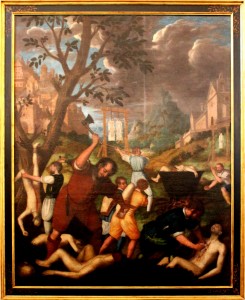 On 19th June 1535, Sebastian Newdigate, William Exmew and Humphrey Middlemore, three Carthusian monks from the London Charterhouse, were hanged, drawn and quartered at Tyburn for refusing to accept King Henry VIII as the Supreme Head of the Church.
On 19th June 1535, Sebastian Newdigate, William Exmew and Humphrey Middlemore, three Carthusian monks from the London Charterhouse, were hanged, drawn and quartered at Tyburn for refusing to accept King Henry VIII as the Supreme Head of the Church.
Chronicler and Windsor Herald Charles Wriothesley recorded their executions in his chronicle:
“The 19th day of June, beinge Saterday, the 3 muncks of the Charterhowsse, afore written, were drawne from the Tower to Tyborne, and there were executed accordinge to their judgment, and their heades and bodies hanged at diverse gates aboute the Cittie.”1
They had been found guilty of high treason when they appeared in front of the King’s Bench at Westminster of 11th June 1535 and condemned to death. They were not the only Carthusian monks to suffer in this way; between May 1535 and August 1540 eighteen Carthusian monks were put to death for the same crime. Letters and Papers has the following record of their deaths:
“In 1535 eighteen of the Charterhouse were condemned for defending the liberty of the Church. Seven of them, viz., John Houghton, Robt. Lawrence, Austen Webster, Humfrey Middellmore, Wm. Exmeu, Sebastian Newdegate, and Wm. Horne, were drawn on hurdles through the city of London to the open place of execution, and there hanged, quartered, &c. Three of them, Humfrey, William, and Sebastian, had stood in prison upright, chained from their necks to their arms, and their legs fettered with locks and chains for 13 days. Their quarters were hanged on the gates and walls of the city and on the gate of the Charterhouse. Two of the eighteen, John Rochester and James Walwercke, remained hanging. The other nine died in prison with stink and miserably smothered, “the which were these that follow.”…”2
All eighteen Carthusian monks have been recognised by the Catholic Church as martyrs.
Back in May, I visited La Cartuja in Granada, Spain, the Carthusian monastery which has a series of paintings by Fray Juan Sánchez Cotán of the various persecutions of the Carthusian order. In this series, there are a number of paintings of the London Charterhouse monks – Sánchez Cotán depicts the monks being brought before Cromwell, some of the monks being imprisoned and chained in an upright position and others being hanged, drawn and quartered. Here is a slideshow of those paintings:
[slideshow id=533 w=400 h=400]
You can read more about the Carthusian monks in a previous article I wrote on the subject – click here.
Notes and Sources
- Wriothesley, Charles. A Chronicle of England during the reigns of the Tudors, from A.D. 1485 to 1559, Volume I, p29
- LP viii. 895